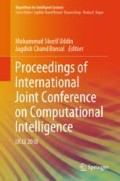Abstract
A machine learning based Distributed Denial of Service (DDoS) attack detection system, implemented in a virtual SDN environment testbed, has been presented in this paper. This system identifies whether any incoming traffic in a network is a DDoS type or not. To implement this approach, we applied AdaBoosting with decision stump as a weak classifier to train our model on a private network dataset in SDN environment. Our model showed up to 93% detection accuracy with a low false-positive rate. We have also tested and compared our model’s accuracy with different machine learning algorithms and presented the result.
Access this chapter
Tax calculation will be finalised at checkout
Purchases are for personal use only
References
Eskca EB, Abuzaghleh O, Bondugula S, Joshi P, Nakayama T, Sultana A (2015) Software defined networks security: an analysis of issues and solutions. Int J Sci Eng Res 6:1270–1275
Ashraf J, Latif S ( 2014) Handling intrusion and DDoS attacks in software defined networks using machine learning techniques. In: Software engineering conference (NSEC), pp 55–60
Abdou A, Barrera D, van Oorschot PC (2016) What lies beneath? analyzing automated SSH bruteforce attacks. In: International conference on PASSWORDS 2015: technology and practice of passwords, pp 72–91
Qazi ZA, Jin T, Lee J, Bellala G, Arndt M, Noubir G (2013) Application awareness in SDN. ACM SIGCOMM Comput Commun Rev 43:487–488
Gupta KD, Sen S (2018) A genetic algorithm approach to regenerate image from a reduce scaled image using bit data count. BRAIN. Broad Res Artif Intell Neurosci 9:34–44
Ali ST, Sivaraman V, Radford A, Jha S (2015) A survey of securing networks using software defined networking. IEEE Trans Reliab 64:1086–1097
LongTail (2018) Longtail log analysis. Accessed 24 Nov 2018. Retrieved from http://longtail.it.marist.edu/honey/
Sommer V (2014) Anamoly detection in SDN control plane. Masters thesis, Technical university of Munich, Munich, Germany
Kim H, Feamster N (2013) Improving network management with software defined networking. IEEE Commun Mag 51:114–119
Keller E, Drutskoy D, Rexford J (2013) Scalable network virtualization in software-defined networks. IEEE Internet Comput 17:20–27
Atkinson RC, Bellekens XJ, Hodo E, Hamilton A, Tachtatzis C (2017) Shallow and deep networks intrusion detection system: a taxonomy and survey, pp 1–43
Niyaz Q, Sun W, Javaid AY, Alam M (2016) A deep learning approach for network intrusion detection system. In: International conference wireless networks and mobile communications (WINCOM), pp 258–263
Syarif I, Prugel-Bennett A, Wills G (2012) Unsupervised clustering approach for network anomaly detection. In: International conference on networked digital technologies NDT 2012: networked digital technologies, pp 135–145
Bennett KP, Demiriz A (1999) Semi-supervised support vector machines. In: Neural information processing systems, pp 1–7
Chen C, Gong Y, Tian Y (2008) Semi-supervised learning methods for network intrusion detection. IEEE Int Conf Syst Man Cybern 2603–2608
Hinton G, LeCun Y, Bengio Y (2015) Deep learning review. Weekly journal of science in nature international. Nature 521:436–444
Reza MBI, Aburomman AA (2016) Survey of learning methods in intrusion detection systems. In: International conference on advances in electrical, electronic and systems engineering (ICAEES), pp 362–365
OVS-ofctl (2018) Open flow switch management commands. OpenVSwitch.org, Last Retrieved on 24 Nov 2018. http://OpenVSwitch.org/support/dist-docs/ovs-fctl.8.txt
Mininet Team (2018) Mininet overview. Last Retrieved on 24 Nov 2018. Retrieved from http://mininet.org/overview/
Phaal P, Lavine M (2018) sflow version 5. sFlow.Org, Last Retrieved on 24 Nov 2018. Retrieved from https://sflow.org/sflow_version_5:txt
Author information
Authors and Affiliations
Corresponding author
Editor information
Editors and Affiliations
Rights and permissions
Copyright information
© 2020 Springer Nature Singapore Pte Ltd.
About this paper
Cite this paper
Sen, S., Gupta, K.D., Manjurul Ahsan, M. (2020). Leveraging Machine Learning Approach to Setup Software-Defined Network(SDN) Controller Rules During DDoS Attack. In: Uddin, M., Bansal, J. (eds) Proceedings of International Joint Conference on Computational Intelligence. Algorithms for Intelligent Systems. Springer, Singapore. https://doi.org/10.1007/978-981-13-7564-4_5
Download citation
DOI: https://doi.org/10.1007/978-981-13-7564-4_5
Published:
Publisher Name: Springer, Singapore
Print ISBN: 978-981-13-7563-7
Online ISBN: 978-981-13-7564-4
eBook Packages: Intelligent Technologies and RoboticsIntelligent Technologies and Robotics (R0)

